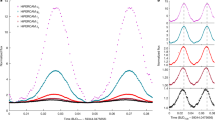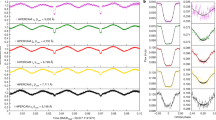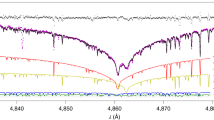Abstract
Mass, radius and age are three of the most fundamental parameters for celestial objects, enabling insight into the evolution and internal physics of stars, brown dwarfs and planets. Brown dwarfs are hydrogen-rich objects that are unable to sustain core fusion reactions but are supported against collapse by electron degeneracy pressure1. As they age, brown dwarfs cool, reducing their radius and luminosity. Young exoplanets follow a similar behaviour. Brown dwarf evolutionary models are relied upon to infer the masses, radii and ages of young brown dwarfs2,3. Similar models are also used to infer the mass and radius of directly imaged exoplanets4. Unfortunately, only sparse empirical mass, radius and age measurements are currently available, and so the models remain mostly unvalidated. Double-line eclipsing binaries provide the most direct route towards the absolute determination of the masses and radii of stars5,6,7. Here we report the discovery by SPECULOOS (Search for habitable Planets EClipsing ULtra-cOOl Stars) of the 2M1510A triple system, consisting of a nearby, eclipsing, double-line brown dwarf binary and a widely separated tertiary brown dwarf companion. We find that the system is a member of Argus, a 45 ± 5 million-year-old moving group8,9. The system’s age matches those of currently known directly imaged exoplanets so 2M1510A provides an opportunity to benchmark evolutionary models of brown dwarfs and young planets. We find that widely used evolutionary models3 do reproduce the mass, radius and age of the binary components remarkably well, but overestimate their luminosity by up to 0.65 magnitudes, which could result in underestimations of 20% to 35% of photometric masses for directly imaged exoplanets and young-field brown dwarfs.
This is a preview of subscription content, access via your institution
Access options
Access Nature and 54 other Nature Portfolio journals
Get Nature+, our best-value online-access subscription
$29.99 / 30 days
cancel any time
Subscribe to this journal
Receive 12 digital issues and online access to articles
$119.00 per year
only $9.92 per issue
Buy this article
- Purchase on Springer Link
- Instant access to full article PDF
Prices may be subject to local taxes which are calculated during checkout



Similar content being viewed by others
Data availability
All reduced photometric timeseries will be made available for download at the CDS, and on request to A.H.M.J.T. Raw SPECULOOS CCD frames will become available through the ESO archive in January 2021; they can be requested from the authors before this date. Eventually the archive will also contain lightcurves for all reference stars in the frames as well. Our UVES spectra are now publicly available on the ESO archive, and can be found by searching the archive for ProgID 299.C-5046 and 2100.C-5024. MONET-South raw images can be made available upon request. NIRSPEC spectra are available at the Keck Observatory Archive, and can be found be searching the archive for Principal Investigator A.J.B. and programmes U009, U010 and U136. SpeX spectra are now available via SPLAT (https://github.com/aburgasser/splat). Requests concerning the data used in this publication can be addressed to A.H.M.J.T. and A.J.B. Figure 1 contains SPECULOOS photometry, as well as UVES and NIRSPEC spectra.
Code availability
The photometric reduction packages use standard public routines such as PyRAF and astropy. Radial velocities were extracted from UVES and NIRSpec data from a code built from elements of SPLAT (https://github.com/aburgasser/splat). The amelie code combines ellc and emcee (see text), which are both public codes. amelie can be made available upon request, and a stable version is planned to be released on GitHub.
References
Kumar, S. S. On the nature of Van Briesbroeck’s star BD +4 4048 B. Astron. J. 68, 283 (1963).
Burrows, A. et al. A nongray theory of extrasolar giant planets and brown dwarfs. Astrophys. J. 491, 856 (1997).
Baraffe, I. et al. New evolutionary models for pre-main sequence and main sequence low-mass stars down to the hydrogen-burning limit. Astron. Astrophys. 577, A42 (2015).
Baraffe, I. et al. Evolutionary models for cool brown dwarfs and extrasolar giant planets. The case of HD 209458. Astron. Astrophys. 402, p701–712 (2003).
Hilditch, R. W. An Introduction to Close Binary Stars (Cambridge Univ. Press, 2001).
Torres, G., Andersen, J. & Giménez, A. Accurate masses and radii of normal stars: modern results and applications. Astron. Astrophys. Rev. 18, 67–127 (2010).
David, T. J. et al. Age determination in Upper Scorpius with eclipsing binaries. Astrophys. J. 872, 161 (2019).
Gagné, J. et al. BANYAN. VII. A new population of young substellar candidate members of nearby moving groups from the BASS survey. Astrophys. J. Suppl. 219, 33 (2015).
Zuckerman, B. The nearby, young, Argus association: membership, age, and dusty debris disks. Astrophys. J. 870, 27 (2019).
Stassun, K. G., Mathieu, R. D. & Valenti, J. A. Discovery of two young brown dwarfs in an eclipsing binary. Nature 440, p311–314 (2006).
Stassun, K. G. et al. A surprising reversal of temperatures in the brown dwarf eclipsing binary 2MASS J05352184-0546085. Astrophys. J. 664, 1154 (2007).
Stassun, K. G. et al. An empirical correction for activity effects on the temperatures, radii, and estimated masses of low-mass stars and brown dwarfs. Astrophys. J. 756, 47 (2012).
Triaud, A. H. M. J. et al. The EBLM project. I. Physical and orbital parameters, including spin-orbit angles, of two low-mass eclipsing binaries on opposite sides of the brown dwarf limit. Astron. Astrophys. 549, A19 (2013).
Hodžić, V. et al. WASP-128b: a transiting brown dwarf in the dynamical-tide regime. Mon. Not. R. Astron. Soc. 481, 5091–5097 (2018).
Cutri, R. M. et al. VizieR Online Data Catalog: 2MASS All-Sky Catalog of Point Sources (Centre de Données astronomique de Strasbourg, 2003); http://adsabs.harvard.edu/abs/2003yCat.2246….0C
Gizis, J. E. Brown dwarfs and the TW Hydrae association. Astrophys. J. 575, 484–492 (2002).
Bailer-Jones, C. A. et al. Estimating distance from parallaxes. IV. Distances to 1.33 billion stars in Gaia Data Release 2. Astron. J. 156, 58 (2018).
Delrez, L. et al. SPECULOOS: a network of robotic telescopes to hunt for terrestrial planets around the nearest ultracool dwarfs. Proc. SPIE 10700, 11 (2018).
Gillon, M. et al. Seven temperate terrestrial planets around the nearby ultracool dwarf star TRAPPIST-1. Nature 542, 456–460 (2017).
McLean, I. S. et al. Design and development of NIRSPEC: a near-infrared echelle spectrograph for the Keck II telescope. Proc. SPIE 3354, 566 (1998).
Dekker, H. et al. Design, construction, and performance of UVES, the echelle spectrograph for the UT2 Kueyen Telescope at the ESO Paranal Observatory. Proc. SPIE 4008, 534 (2000).
Maxted, P. F. L. ellc: A fast, flexible light curve model for detached eclipsing binary stars and transiting exoplanets. Astron. Astrophys. 591, A111 (2016).
Foreman-Mackey, D. et al. emcee: the MCMC hammer. Publ. Astron. Soc. Pacif. 125, 306 (2013).
Dupuy, T. J., Brandt, T. D., Kratter, K. M. & Bowler, B. P. A model-independent mass and moderate eccentricity for β Pic b. Astrophys. J. Lett. 871, 4 (2019).
Liu, M. C., Dupuy, T. & Allers, K. N. The Hawaii Infrared Parallax Program. II. Young ultracool field dwarfs. Astrophys. J. 833, 96 (2016).
Lagrange, A.-M. et al. A probable giant planet imaged in the β Pictoris disk. VLT/NaCo deep L’-band imaging. Astron. Astrophys. 493, L21–L25 (2009).
Triaud, A. H. M. J. et al. The EBLM Project IV. Spectroscopic orbits of over 100 eclipsing M dwarfs masquerading as transiting hot-Jupiters. Astron. Astrophys. 608, A129 (2017).
Moe, M. & Kratter, K. M. Dynamical formation of close binaries during the pre-main-sequence phase. Astrophys. J. 854, 44 (2018).
Mazeh, T. & Shaham, J. The orbital evolution of close triple systems—the binary eccentricity. Astron. Astrophys. 77, 145–151 (1979).
Fabrycky, D. & Tremaint, S. Shrinking binary and planetary orbits by Kozai cycles with tidal friction. Astrophys. J. 669, 1298–1315 (2007).
Bischoff, K. et al. MONET/North: a very fast 1.2m robotic telescope. Proc. SPIE 6270, id. 62701Q (2006).
Bowler, B. P. Imaging extrasolar giant planets. Publ. Astron. Soc. Pacif. 128, 102001 (2016).
Tody, D. The IRAF data reduction and analysis system. Proc. SPIE 627, 733 (1986).
Rayner, J. T. et al. SpeX: a medium-resolution 0.8-5.5 micron spectrograph and imager for the NASA Infrared Telescope Facility. Publ. Astron. Soc. Pacif. 115, 362 (2003).
Vacca, W. D., Cushing, M. C. & Rayner, J. T. A method of correcting near-infrared spectra for telluric absorption. Publ. Astron. Soc. Pacif. 115, 389 (2003).
Cushing, M. C., Vacca, W. D. & Rayner, J. T. Spextool: a spectral extraction package for SpeX, a 0.8-5.5 micron cross-dispersed spectrograph. Publ. Astron. Soc. Pacif. 116, 326 (2004).
Kirkpatrick, J. D. et al. Discoveries from a near-infrared proper motion survey using multi-epoch Two Micron All-Sky Survey data. Astrophys. J. Suppl. 190, 100 (2010).
Allers, K. N. & Liu, M. C. A near-infrared spectroscopic study of young field ultracool dwarfs. Astrophys. J. 772, 79 (2013).
Cruz, K. L. et al. Meeting the cool neighbors. XII. An optically anchored analysis of the near-infrared spectra of L dwarfs. Astron. J. 155, 34 (2018).
Bell, C. P. M., Mamajek, E. E. & Naylor, T. A self-consistent, absolute isochronal age scale for young moving groups in the solar neighbourhood. Mon. Not. R. Astron. Soc. 454, 593 (2015).
Looper, D. L. et al. Discovery of an M9.5 candidate brown dwarf in the TW Hydrae association: DENIS J124514.1-442907. Astrophys. J. Lett. 669, L97 (2007).
Burgasser, A. J. et al. The Brown Dwarf Kinematics Project (BDKP). IV. Radial velocities of 85 late-M and L dwarfs with MagE. Astrophys. J. Suppl. 220, 18 (2015).
Modigliani, A. & Larsen, J. M. FLAMES-UVES Pipeline User Manual VLT-MAN-ESO-19500-3016 (European Southern Observatory, 2018); ftp://ftp.eso.org/pub/dfs/pipelines/uves/uves-fibre-pipeline-manual-18.8.1.pdf
Blake, C. H., Charbonneau, D. & White, R. J. The NIRSPEC Ultracool Dwarf Radial Velocity Survey. Astrophys. J. 723, 684 (2010).
Burgasser, A. J. et al. The orbit of the L dwarf + T dwarf spectral binary SDSS J080531.84 + 481233.0. Astrophys. J. 827, 25 (2016).
Burgasser, A. J. et al. The SpeX Prism Library Analysis Toolkit (SPLAT): a data curation model. Astron. Soc. India Conf. Ser. 14, 7–12 (2017).
Moehler, S. et al. Flux calibration of medium-resolution spectra from 300 nm to 2500 nm: model reference spectra and telluric correction. Astron. Astrophys. 568, A9 (2014).
Allard, F., Homeier, D. & Freytag, B. Models of very-low-mass stars, brown dwarfs and exoplanets. Phil. Trans. R. Soc. A 370, 2765–2777 (2012).
Gray, D. F. The Observation And Analysis Of Stellar Photospheres Vol. 20 (Cambridge Astrophysical Series, 1992); http://adsabs.harvard.edu/abs/1992oasp.book…..G
Metropolis, N. et al. Equation of state calculations by fast computing machines. J. Chem. Phys. 21, 1087 (1953).
Hastings, W. K. Monte Carlo sampling methods using Markov chains and their applications. Biometrika 57, 97–109 (1970).
Geman, S. & Geman, D. Stochastic relaxation, Gibbs distributions, and the Bayesian restoration of images. IEEE Trans. Pattern Anal. Mach. Intell. 6, 721–741 (1984).
Roberts, G. & Rosenthal, J. Optimal scaling of discrete approximations to Langevin diffusions. J. R. Stat. Soc. B 160, 255–268 (1998).
Kim, S., Prato, L. & McLean, I. S. REDSPEC: NIRSPEC Data Reduction (Astrophysical Source Code Library, 2015); http://adsabs.harvard.edu/abs/2015ascl.soft07017K
Gagné, J. et al. BANYAN. XI. The BANYAN σ multivariate Bayesian algorithm to identify members of young associations with 150 pc. Astrophys. J. 856, 23 (2018).
Zuckerman, B. et al. The Tucana/Horologium, Columba, AB Doradus, and Argus associations: new members and dusty debris disks. Astrophys. J. 732, 61 (2011).
Barrado y Navascues, D. et al. Spectroscopy of Very Low Mass Stars and BrownDwarfs in IC 2391: Lithium Depletion and Hα Emission. Astrophys. J. 614, 386 (2004).
Torres, C. A., et al. in Handbook of Star Forming Regions. Volume II: The Southern Sky Vol. 5 (ed. Reipurth, B) 757 (ASP Monograph Publ, 2008).
von Boetticher, A. et al. The EBLM project. III. A Saturn-size low-mass star at the hydrogen-burning limit. Astron. Astrophys. 604, L6 (2017).
Southworth et al. Absolute dimensions of detached eclipsing binaries—I. The metallic-lined system WW Aurigae. Mon. Not. R. Astron. Soc. 363, 529–542 (2005).
Gelman, A. & Rubin, D. B. Inference from iterative simulation using multiple sequences. Stat. Sci. 7, 4 (1992).
Gelman A., Carlin J., Stern H. & Rubin D. Bayesian Data Analysis 2nd edn (Chapman & Hall/CRC Texts in Statistical Science, Taylor & Francis, 2003).
Schwarz, G. Estimating the dimension of a model. Ann. Stat. 6, 2 (1978).
Parviainen, H. & Aigrain, S. LDTK: Limb Darkening Toolkit. Mon. Not. R. Astron. Soc. 453, 3821 (2015).
Husser, T.-O. et al. A new extensive library of PHOENIX stellar atmospheres and synthetic spectra. Astron. Astrophys. 553, A6 (2013).
Filippazzo, J. C. et al. Fundamental parameters and spectral energy distributions of young and field age objects with masses spanning the stellar to planetary regime. Astrophys. J. 810, 158 (2015).
Hut, P. Tidal evolution in close binary systems. Astron. Astrophys. 99, 126–140 (1981).
Kiseleva, L. G. et al. Tidal friction in triple stars. Mon. Not. R. Astron. Soc. 300, 292 (1998).
Tokovinin, A. & Moe, M. Formation of close binaries by disc fragmentation andmigration, and its statistical modeling, Mon. Not. R. Astron. Soc. 5158–5171 (2020).
Acknowledgements
We thank the personnel of ESO who host SPECULOOS at Paranal Observatory, and who have awarded two Director Discretionary Time (DDT) programmes to confirm this object (Prog ID 099.C-0138 and 2100.C-5024, Principal Investigator A.H.M.J.T.). In addition, we thank C. Alvarez, G. Doppman, P. Gomez, H. Hershey and J. Rivera at the Keck Observatory and G. Osterman and E. Volquardsen at the Infra-Red Telescope Facility, for their assistance with the observations reported here. This work also used observations from the Las Cumbres Observatory Global Telescope network, awarded through a DDT programme (PI Alonso). We made use of PyRAF, which is a product of the Space Telescope Science Institute, which is operated by the Association of Universities for Research in Astronomy (AURA) for NASA. PyRAF uses the Image Reduction and Analysis Facility, which is distributed by the National Optical Astronomy Observatory, which is operated by AURA, under cooperative agreement with the National Science Foundation. We used the SIMBAD database, operated at Centre de Données astronomique de Strasbourg, Strasbourg, France; NASA’s Astrophysics Data System Bibliographic Services; the M, L, T and Y dwarf compendium housed at DwarfArchives.org; and the SpeX Prism Libraries (http://www.browndwarfs.org/spexprism). We recognize and acknowledge the very significant cultural role and reverence that the summit of Mauna Kea has always had within the indigenous Hawaiian community. We are most fortunate and grateful to have the opportunity to conduct observations from this mountain. This research also made use of Astropy (www.astropy.org), a community-developed core python package for astronomy as well as the open-source python packages numpy (www.numpy.org), scipy (www.scipy.org) and matplotlib (www.matplotlib.org). A.H.M.J.T. received funding from the European Research Council (ERC) under the European Union’s Horizon 2020 research and innovation programme (grant agreement number 803193/BEBOP). A.H.M.J.T. also received funding from the Leverhulme Trust (Research Project Grant number RPG-2018-418) and from the Science, Technology and Facilities Council (grant number ST/S00193X/1). A.J.B. acknowledges funding support from the National Science Foundation (award number AST-1517177). The material is based upon work supported by NASA (grant number NNX15AI75G). B.-O.D. acknowledges support from the Swiss National Science Foundation (PP00P2-163967). M.G. received funding from the ERC (FP/2007-2013 grant agreement number 336480/SPECULOOS), from an ARC grant for Concerted Research Actions, financed by the Wallonia-Brussels Federation, from the Simons Foundation, and from the MERAC foundation. M.G. and E.J. are Senior Research Associates at the Fonds de la Recherche Scientifique–Fond National de la Recherche Scientifique. L.D. acknowledges support from the Gruber Foundation Fellowship. V.K.H. is supported by a generous Birmingham Doctoral Scholarship and by a studentship from Birmingham’s School of Physics and Astronomy.
Author information
Authors and Affiliations
Contributions
A.H.M.J.T. led the data acquisition, obtained UVES data, and organised the analysis and interpretation of this system. A.J.B. obtained the NIRSPEC data, extracted radial velocities from NIRSPEC and UVES data, produced early parameters of the system, and performed the spectral typing and assessment of Argus membership. A.B. and V.K.H. led the photometric follow-up. A.B., E.D., C.M., P.P.P., L.D. and M.G. reduced the photometric data. V.K.H. produced the global analysis. M.G., E.J., D.S., B.-O.D., D.Q., L.D., C.M., P.P.P., J.d.W., A.H.M.J.T., E.D., A.B. and S.T. participated with the preparation, construction and running of the SPECULOOS facility/survey. J.MC. provided the DONUTS software used for guiding. D.B.G. provided the SpeX data while R.A., F.H. and T.-O.H. participated in the photometric follow-up. V.V.G. calculated stellar models. All authors assisted in writing the manuscript.
Corresponding authors
Ethics declarations
Competing interests
The authors declare no competing interests.
Additional information
Peer review information Nature Astronomy thanks Víctor Béjar, Keivan Stassun and the other, anonymous, reviewer(s) for their contribution to the peer review of this work.
Publisher’s note Springer Nature remains neutral with regard to jurisdictional claims in published maps and institutional affiliations.
Supplementary information
Supplementary Information
The file contains figures and tables cited in the Methods.
Rights and permissions
About this article
Cite this article
Triaud, A.H.M.J., Burgasser, A.J., Burdanov, A. et al. An eclipsing substellar binary in a young triple system discovered by SPECULOOS. Nat Astron 4, 650–657 (2020). https://doi.org/10.1038/s41550-020-1018-2
Received:
Accepted:
Published:
Issue Date:
DOI: https://doi.org/10.1038/s41550-020-1018-2



